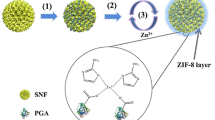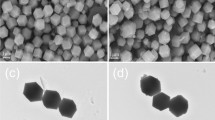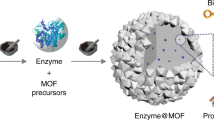Abstract
Metal–organic frameworks (MOFs) have been recently studied for a variety of applications because of their huge surface area, large porosity, and tunable functionality. In this work, for the first time, the efficient immobilization of l-asparaginase (ASNase, EC 3.5.1.1) by using MOF as a simple and novel support is demonstrated. The functional groups, morphology, chemical composition, and crystal structure of the support and immobilized ASNase were investigated by using different methods, including Fourier transform infrared spectroscopy, scanning electron microscopy, energy-dispersive spectrometer, and X-ray diffraction. Afterward, the enzymatic activities and thermodynamic parameters of the immobilized l-ASNase (ASNase@ZIF-8) were compared with free one. After enzyme immobilization, the optimum temperature shifted from 50 to 60 °C, while the optimum pH remains unchanged at 9.0. However, the pH and thermal stability of the ASNase@ZIF-8 was significantly improved compared to the free one. The ASNase@ZIF-8 displayed an excellent long-term storage stability, which could protect more than 56% of the initial activity at 25 °C for 4 weeks. Besides, the ASNase@ZIF-8 had high reusability, which showed a high degree of activity (more than 45%) after 10 cycles. Km and Vmax values were 0.18 mM and 64.5 µmol/min for ASNase@ZIF-8 and those for free ASNase were 0.40 mM and 68.0 µmol/min, respectively. The proposed support based on ZIF-8 was superior in terms of high enzyme loading capacity (82.0%), high enzyme catalytic activity, and easy preparation process. Overall, newly developed support for ASNase may provide a new platform for its biotechnological applications.











Similar content being viewed by others
References
Xie T, Wang A, Huang L, Li H, Chen Z, Wang Q, Yin X (2009) Recent advance in the support and technology used in enzyme immobilization. Afr J Biotechnol 8:4724–4733
Brady D, Jordaan J (2009) Advances in enzyme immobilisation. Biotechnol Lett 31:1639–1650
Nadar SS, Rathod VK (2019) One pot synthesis of α-amylase metal organic framework (MOF)-sponge via dip-coating technique. Int J Biol Macromol 138:1035–1043
Sheldon RA, van Pelt S (2013) Enzyme immobilisation in biocatalysis: Why, What and How. Chem Soc Rev 42:6223–6235
Sheldon RA (2007) Enzyme immobilization: the quest for optimum performance. Adv Synth Catal 349:1289–1307
Datta S, Christena LR, Rajaram YR (2013) Enzyme immobilization: an overview on techniques and support materials. 3Biotech 3:1–9
Cui J, Feng Y, Jia S (2018) Silica encapsulated catalase@metal–organic framework composite: a highly stable and recyclable biocatalyst. Chem Eng J 351:506–514
Samui A, Kumar Sahu S (2018) One-pot synthesis of microporous nanoscale metal organic frameworks conjugated with laccase as a promising biocatalyst. New J Chem 42:4192–4200
Nadar SS, Rathod VK (2019) Immobilization of proline activated lipase within metal organic framework (MOF). Int J Biol Macromol. https://doi.org/10.1016/j.ijbiomac.2019.10.199
Salgaonkar M, Nadar SS, Rathod VK (2019) Biomineralization of orange peel peroxidase within metal organic frameworks (OPP–MOFs) for dye degradation. J Environ Chem Eng 7:102969
Nadar SS, Vaidya L, Maurya S, Rathod VK (2019) Polysaccharide based metal organic frameworks (polysaccharide-MOF): a review. Coord Chem Rev 396:1–21
Tadepalli S, Yim J, Cao S, Wang Z, Naik RR, Singamaneni S (2018) Metal–organic framework encapsulation for the preservation and photothermal enhancement of enzyme activity. Small 14:1702382
Liu X, Chen W, Lian M, Chen X, Lu Y, Yang W (2019) Enzyme immobilization on ZIF-67/MWCNT composite engenders high sensitivity electrochemical sensing. J Electroanal Chem 833:505–511
Cao SL, Yue DM, Li XH, Smith TJ, Li N, Zong MH, Wu H, Ma YZ, Lou WY (2016) Novel nano-/micro-biocatalyst: soybean epoxide hydrolase immobilized on UiO-66-NH2 MOF for efficient biosynthesis of enantiopure (R)-1, 2-octanediol in deep eutectic solvents. ACS Sustain Chem Eng 4:3586–3595
Ren S, Feng Y, Wen H, Li C, Sun B, Cui J, Jia S (2018) Immobilized carbonic anhydrase on mesoporous cruciate flower-like metal organic framework for promoting CO2 sequestration. Int J Biol Macromol 117:189–198
Wang Q, Zhang X, Huang L, Zhang Z, Dong S (2017) GOx@ZIF-8(NiPd) Nanoflower: an artificial enzyme system for tandem catalysis. Angew Chem Int Ed 56:16082–16085
Nadar SS, Rathod VK (2018) Encapsulation of lipase within metal–organic framework (MOF) with enhanced activity intensified under ultrasound. Enzyme Microb Technol 108:11–20
Patra S, Sene S, Mousty C, Serre C, Chaussé A, Legrand L, Steunou N (2016) Design of laccase-metal organic framework-based bioelectrodes for biocatalytic oxygen reduction reaction. ACS Appl Mater Interfaces 8:20012–20022
Ulu A, Koytepe S, Ates B (2016) Design of starch functionalized biodegradable P(MAA-co-MMA) as carrier matrix for l-asparaginase immobilization. Carbohydr Polym 153:559–572
Cachumba JJM, Antunes FAF, Peres GFD, Brumano LP, Santos JC, Da Silva SS (2016) Current applications and different approaches for microbial l-asparaginase production. Braz J Microbiol 47:77–85
Onishi Y, Prihanto AA, Yano S, Takagi K, Umekawa M, Wakayama M (2015) Effective treatment for suppression of acrylamide formation in fried potato chips using l-asparaginase from Bacillus subtilis. 3 Biotech 5:783–789
Ashok A, Doriya K, Rao JV, Qureshi A, Tiwari AK, Kumar DS (2019) Microbes producing l-asparaginase free of glutaminase and urease isolated from extreme locations of antarctic soil and moss. Sci Rep 9:1423
Asselin B, Rizzari C (2015) Asparaginase pharmacokinetics and implications of therapeutic drug monitoring. Leuk Lymphoma 56:2273–2280
Brumano LP, da Silva FVS, Costa-Silva TA, Apolinário AC, Santos JHPM, Kleingesinds EK, Monteiro G, Rangel-Yagui CO, Benyahia B, Junior AP (2019) Development of l-asparaginase biobetters: current research status and review of the desirable quality profiles. Front Bioeng Biotechnol 6:212
Ulu A, Ates B (2017) Immobilization of l-asparaginase on carrier materials: a comprehensive review. Bioconjug Chem 28:1598–1610
Cui J, Feng Y, Lin T, Tan Z, Zhong C, Jia S (2017) Mesoporous metal–organic framework with well-defined cruciate flower-like morphology for enzyme immobilization. ACS Appl Mater Interfaces 9:10587–10594
Wriston JC, Yellin TO (1973) l-asparaginase: a review. Adv Enzymol Relat Areas Mol Biol 39:185–248
Agrawal S, Kango N (2019) Development and catalytic characterization of l-asparaginase nano-bioconjugates. Int J Biol Macromol 135:1142–1150
Patil PD, Yadav GD (2018) Rapid in situ encapsulation of laccase into metal–organic framework support (ZIF-8) under biocompatible conditions. Chem Select 3:4669–4675
Dhiman S, Srivastava B, Singh G, Khatri M, Arya SK (2019) Immobilization of mannanase on sodium alginate-grafted-β-cyclodextrin: an easy and cost effective approach for the improvement of enzyme properties. Int J Biol Macromol. https://doi.org/10.1016/j.ijbiomac.2019.11.175
Li X, Gao X, Ai L, Jiang J (2015) Mechanistic insight into the interaction and adsorption of Cr(VI) with zeolitic imidazolate framework-67 microcrystals from aqueous solution. Chem Eng J 274:238–246
Shen Y, Li W, Wu J, Li S, Luo H, Dai S, Wu W (2014) Solvent extraction of lanthanides and yttrium from aqueous solution with methylimidazole in an ionic liquid. Dalt Trans 43:10023–10032
Esfahanian M, Ghasemzadeh MA, Razavian SMH (2019) Synthesis, identification and application of the novel metal–organic framework Fe3O4@PAA@ZIF-8 for the drug delivery of ciprofloxacin and investigation of antibacterial activity. Artif Cells Nanomed Biotechnol 47:2024–2030
Adnan M, Li K, Xu L, Yan Y (2018) X-shaped ZIF-8 for immobilization rhizomucor miehei lipase via encapsulation and its application toward biodiesel production. Catalysts 8:96
Cao SL, Xu H, Lai LH, Gu WM, Xu P, Xiong J, Yin H, Li XH, Ma YZ, Zhou J, Zong MH, Lou WY (2017) Magnetic ZIF-8/cellulose/Fe3O4 nanocomposite: preparation, characterization, and enzyme immobilization. Bioresour Bioprocess 4:56
Trivedi MK, Branton A, Trivedi D, Nayak G, Saikia G, Jana S (2015) Physical and structural characterization of biofield treated imidazole derivatives. Nat Prod Chem Res 3:5
Wu X, Ge J, Yang C, Hou M, Liu Z (2015) Facile synthesis of multiple enzyme-containing metal–organic frameworks in a biomolecule-friendly environment. Chem Commun 51:13408–13411
Wang J, Zhao G, Yu F (2016) Facile preparation of Fe3O4@MOF core-shell microspheres for lipase immobilization. J Taiwan Inst Chem Eng 69:139–145
Yan J, Pan G, Ding C, Quan G (2010) Kinetic and thermodynamic parameters of β-glucosidase immobilized on various colloidal particles from a paddy soil. Colloids Surfaces B Biointerfaces 79:298–303
El-Refai HA, Shafei MS, Mostafa H, El-Refai AM, Araby EM, El-Beih FM, Easa SM, Gomaa SK (2016) Comparison of free and immobilized l-asparaginase synthesized by gamma-irradiated penicillium cyclopium. Polish J Microbiol 65:43–50
Gupta G, Sahai V, Gupta RK (2014) Thermal stability and thermodynamics of xylanase from Melanocarpus albomyces in presence of polyols and salts. BioResources 9:5801–5816
Ahmed SA, Saleh SAA, Abdel-Hameed SAM, Fayad AM (2019) Catalytic, kinetic and thermodynamic properties of free and immobilized caseinase on mica glass-ceramics. Heliyon 5:e01674
Vaidya L, Nadar SS, Rathod VK (2019) Entrapment of surfactant modified lipase within zeolitic imidazolate framework (ZIF)-8. Int J Biol Macromol 146:678–686
Tarhan T, Ulu A, Sariçam M et al (2020) Maltose functionalized magnetic core/shell Fe3O4@Au nanoparticles for an efficient l-asparaginase immobilization. Int J Biol Macromol 142:443–451
Ulu A, Noma SAA, Koytepe S, Ates B (2018) Magnetic Fe3O4@MCM-41 core-shell nanoparticles functionalized with thiol silane for efficient l-asparaginase immobilization. Artif Cells Nanomed Biotechnol 46:1035–1045
Acknowledgements
The author would like to thank Dr. Burhan Ates for his helpful advice on various technical issues in this article.
Author information
Authors and Affiliations
Corresponding author
Ethics declarations
Conflict of interest
The author declared no conflict of interest.
Additional information
Publisher's Note
Springer Nature remains neutral with regard to jurisdictional claims in published maps and institutional affiliations.
Rights and permissions
About this article
Cite this article
Ulu, A. Metal–organic frameworks (MOFs): a novel support platform for ASNase immobilization. J Mater Sci 55, 6130–6144 (2020). https://doi.org/10.1007/s10853-020-04452-6
Received:
Accepted:
Published:
Issue Date:
DOI: https://doi.org/10.1007/s10853-020-04452-6




